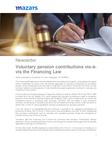
Voluntary pension contributions vis-à-vis the Financing Law
The Financing Bill approved in the first debate before the National Congress, contemplates the repeal and/or modification of some of the tax benefits applicable to voluntary contributions to mandatory pension funds (introduced by the tax reform contained in Law 1819 of December 26, 2016), as well as those made to voluntary pension funds, benefits that seek to generate incentives for savings and investment in the country.
In this context, the Project proposes to repeal the reference made by Article 135 of Law 100 of 1993 to Article 55 of the Tax Statute (ET), which implied that voluntary contributions made to mandatory pensions of the Individual Savings Regime with Solidarity (Rais), were considered as an income not constituting income or occasional gain (Incrngo); Therefore, with the repeal of such remission, voluntary contributions to mandatory pensions will be treated as exempt income under the terms of article 126-1 of the ET, being equated to voluntary contributions to voluntary pensions.
From the above it is highlighted that the remission proposed to be repealed contradicted the provisions of Article 126-1 of the ET, which since it was amended by Law 1607 of 2012, established that voluntary contributions, both to voluntary and mandatory pension funds, are considered as exempt income, and not as an Incrngo.
Therefore, with the Financing Law it would be confirmed that voluntary contributions, without distinction, will be considered exempt income, even though this implies limiting again the tax benefits applicable to this type of contributions.
On the other hand, the Bill proposes to amend Article 55 of the ET, in the sense of including on a transitory basis the provision according to which withdrawals, partial or total, of voluntary contributions made by members of the Individual Savings with Solidarity Regime (Rais) before January 1, 2019, for purposes other than obtaining a higher pension or an early withdrawal, will constitute taxable income in the year in which they are withdrawn, as well as will be subject to withholding at the source at the rate of 15% at the time of withdrawal.
This establishes a transition regime according to which voluntary contributions made to mandatory funds prior to the entry into force of the Financing Law would maintain the treatment in force at the time they were made.
Additionally, the Project under analysis proposes to modify the second paragraph of article 126-1 of the ET, by including in its wording the members of the RAIS.
Consequently, voluntary contributions made to private pension insurance, voluntary and mandatory pension funds, and voluntary contributions made by members of the Rais, will not be part of the basis for applying withholding at source and will be considered as exempt income, up to an amount that, added to the value of the contributions to the AFC Accounts, does not exceed 30% of labor income or tax income for the year, as the case may be, and up to a maximum amount of 3,800 UVT per year. 3,800 UVT per year, having to comply in any case with the conditions described in the same article 126-1, for the purposes of the withdrawal or destination of such voluntary contributions.
The above, without losing sight of the fact that the value to which the voluntary contributions are equivalent, in the terms previously described, must be computed within the limits established for the exempt income and the deductions that may be subtracted from the net taxable income of the earned income, not exceeding 40% of the income less INCRNGO for earned income obtained in the taxable period, without exceeding 5,040 UVT.
Finally, the aforementioned voluntary contributions would continue to be deductible for the employer who makes them up to 3,800 UVT per worker, which for the year 2019 (with the entry into force of the Financing Law) is equivalent to a little more than $130 million pesos.


